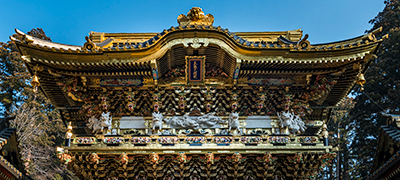Beyond the time,Japanese elegance
The Uruoi (moisture) since the Ancient times
The theory states that Urushi originates from the word “Uruwashi (elegance) / Uruosu (moisturizing).” Indeed, this makes us think it might be true looking at the glossy and sleek colors of the lacquerware. However, this “Uruwashi-no-Urushi (The elegant Urushi)” now seems quite far away from the daily lives of modern people.
How many people actually use Urushi-lacquered bowls for their daily meals? There is probably a good number of families that own lacquered boxes but only use them for Osechi dishes for the new year. They are hard to take care of, expensive, or designed to not match with modern lifestyle… Aren’t they supposed to be in museums to start with?
The reasons not to use the lacquerware may vary, but when it comes down many of these people actually “do not know what Urushi is.”
Urushi considered apart from their daily lives by many people. In fact, it was always about the lives of Japanese people, from the Ancient times. Urushi has been used in places here and there.
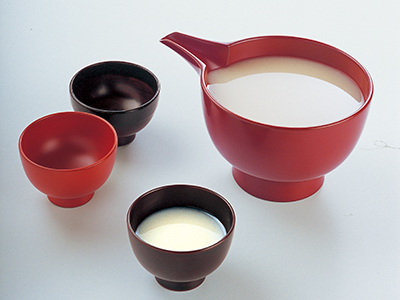
The oldest sites in Japan
Urushi has been used since the Jomon era, and the oldest lacquerware in the world has been known to be made in China from 7,000 years ago. However, this theory was turned over. In Hakodate city, Hokkaido, a burial accessory from approximately 9,000 years ago using Urushi was discovered, which was the oldest in the world. Although in the later time of the history, many lacquered combs and such have also been discovered in Fukui and at Korekawa site of Hachinohe city, Aomori.
The lacquered products from Jomon period have a variety – from containers such as bowls, plates, and pots, and weapons like bows, to decorative products such as combs and bracelets. Another characteristic of the products during this era is that many of them are lacquered in red. Red color would have been the special color for the people of Jomon. There is research that suggests the color comes from blood or soul, meaning amulet, resurrection/revival, or prosperity.
Urushi is a paint and also an adhesive. Red combs are made by Jomon people, mixing the red pigments to Urushi to paint. Broken potteries repaired with Urushi have also been discovered. Tools used for lacquer work have also been excavated, and it is understood that the basic technology leading to the modern age had already been established in this era. In any case, the lacquered products were in the lives of Jomon people, from their daily lives to rituals.
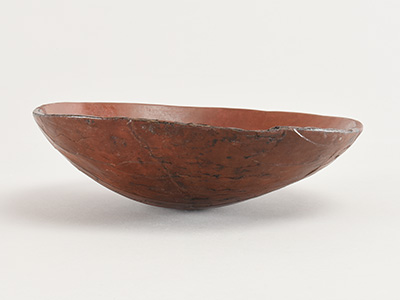
Wooden lacquerware (shallow bowl) from Jomon era discovered at the Korekawa site. The Korekawa site is the remains of late Jomon era (3,000 years ago). Kitai, carved wood, and Rantai, woven strips of bamboo, are coated with Urushi. (Photo credit: Korekawa Jomon Museum)

Combs painted with red Urushi excavated. Out of the 963 pieces of relics from Korekawa site designated to be the important cultural properties, 101 pieces are Urushied products. Gassho Dogu (clay figure in a position of prayer) was excavated from the Kazahari site, in the opposite bank across the river of the Korekawa site. (Photo credit: Korekawa Jomon Museum)
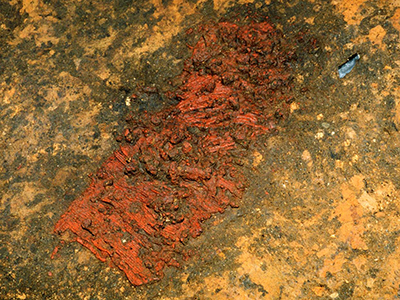
The shoulder part of the burial accessory from head to the legs. It seems the thread itself was dyed with Urushi. With radioactive dating using radiocarbon-14, they were measured as relics from approximately 9000 years ago. World’s oldest lacquer products. (Kakinoshima B site, Hakodate City, Hokkaido) (Photo credit: Hakodate City Board of Education)
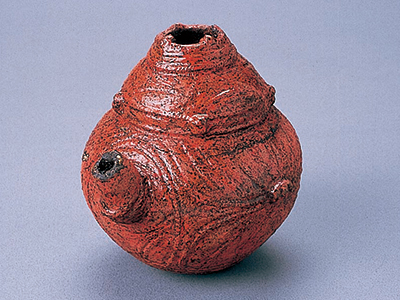
A small Chuko Doki (earthenware with a pouring spout) in the latter half of the late Jomon era. The red lacquer is painted on the whole ware. Kakinoshima ruins are settlement remains facing the Pacific Ocean that shows stable residence from approximately from 7000 BC to 1000 BC. (Historical Kakinoshima Site, Hakodate City, Hokkaido) (Photo credit: Hakodate City Board of Education)
Representing “solemnity” of temples and shrines
As the domestic Urushi from Joboji was used for Nikko Toshogu, Kinkaku-ji Temple, and Chuson-ji Konjikido in Hiraizumi town of Iwate, it is indispensable for restoration and repair of temples and shrines. It was used not only on buildings but also on the altar fittings and Buddha statues. The “Ashura statue” of Kofukuji Temple, Nara, favorite among the fans of Buddha statues, is using the technique called “Dry Lacquer,” which only uses hemp and Urushi. In order to avoid the cracks on the surface, Urushi with high purity was required. It is said to be almost as expensive as the gold. In addition, Urushi was also used for the finishing of the wood carving Buddha statues. Urushi acted as an adhesive for those to be finished with gold foil or powders covering the surface.
Notable buildings using Urushi is Konjikido (Golden Hall) temple, which shows the prosperity of the Fujiwara clan to current. With that in mind, the gold coated appearance catches the eyes, but if you look inside carefully, the decoration is full of superb Urushi art. The gold-covered pillars and altar with fine, exquisite mother of pearl decoration. Buddha is drawn with fine lines using the black Urushi, with the sense of divinity added with Makie. Konjikido temple, with full of excellent techniques, is no exaggeration to say that it is best of the Urushi art. The overwhelming glamor shows the exact world of paradise.
Buddhist altars such as Kyo-butsudan could very well be considered as the home-version of the exquisite work of Urushi, as they are often certified as traditional crafts. In every Japanese home back then, there was almost always a Buddhist altar. A small temple where people of Ichii go for their prayers every day. That is why they made it with maximum luxury. The altar is like a showcase of Urushi art.
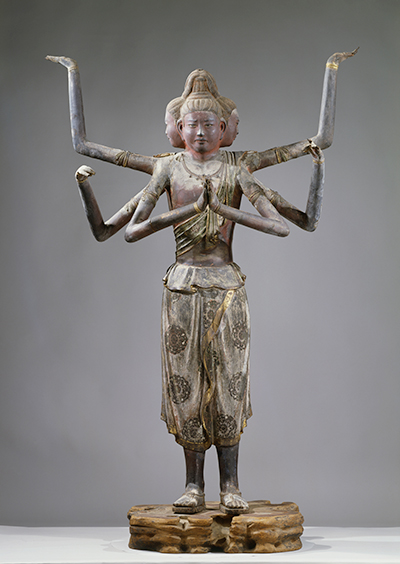
The “National Treasure Ashura Statue” in Kofuku-ji temple is also a dry lacquer statue made with hemp cloth and Urushi. (Photo by: Asukaen Co., Ltd. With permission of Kofukuji Temple)
No Urushi, No Culture?
Urushi for Japanese people was a practical material as a paint and adhesive, as well as a tool to express their sense of beauty. Armors and weapons are the ones embodying such sense. In addition to functionality, with decoration of armor and helmet, they were committed to the design of the sword sheath and collar. The bow was even painted with Urushi. This was to protect from moisture or prevention of damage in the beginning but went further to have drawings and decorations such as Makie/Raden.
The functional element and beauty of Urushi are also present in the Nambu (Southern) cast iron; the traditional craft passed on in the land of Iwate. For the casting of an iron bottle, it is used in the finishing. Once it is heated in the kiln, Urushi is glazed. On top of this, with the coloring process called “Ohaguro,” the gloss of the Urushi will stay deeper in the back, providing the classical taste.
Urushi is also used for the traditional repairing technique of Japan called “Kintsugi,” which attracts interest from overseas. This is done to re-bond the cracked, broken, or scratched porcelain. It uses gold powder to hide the traces of lacquer in the seam of the ware. When the color of this becomes tasteful, it is called “Keshiki (landscape).” People back then broke their ceramic wares on purpose, to add the process of Kintsugi and enjoy other characters of the ware. It is such an artistic story.
Now and then, as described above, Urushi has always been together with the beauty and culture of Japan.
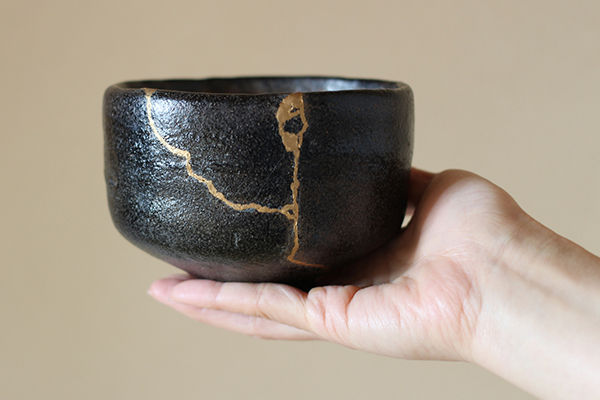
Kintsugi now draws attention from overseas as well. “Mottainai” is an ultimate sense of beauty.
This has progressed to the point where we enjoy this for the sake of it.
Common People wanted lacquerware
The production of lacquerware is done in various places of Japan, from Tsugaru lacquer in Aomori up north to the Ryukyu lacquerware of Okinawa down south. In particular, this is done on the coast of the Japan Sea and the basins. Urushi has a property that takes moisture from the air to change to solid state, and it is hardened at most during the wet raining season. The fact that there are many production sites of lacquer wares in the coastal side of Japan Sea, for instance, Niigata lacquerware in Niigata, Wajima lacquer, Yamanaka lacquerware, Kanazawa lacquerware in Ishikawa, and Echizen lacquerware and Wakasa lacquer of Fukui, is probably caused by the climate in those areas.
Lacquerware made with time and effort using expensive Urushi. Even though they can be used in everyday lives, it’s no surprise people keep them for the special occasions, or consider that they are only for the upper class. However, common people used lacquerware since the middle ages. Using the persimmon tannin as the base, and the lacquer coating is simplified to only 1 to 2 layers. It seems different variations were depending on the lifestyles of the people using the lacquerware, as various species of trees were used as the base. It could be that everyone wanted to use lacquerware with that much effort involved.
For Lifelong Friends
The sap of Urushi tree has made the lacquerware beautiful and durable, but the fruit also supported the lives of people in the past. They squeezed the wax ingredient from the bark of the tree to make candles. The flame of this candle had warming colors. Urushi provided lightings in the time where there was no electricity.
In such era of Japan, thick darkness had existed. The room with only candles would have been dim. There was “beauty” created with such darkness.
The writer Nanizaki Junichiro wrote that the skin of lacquerware is the color made up with many layers of darkness accumulated, in his essay “In Praise of Shadows.” And that the reason so much gold was used in Makie lacquer etc., was to aim for the effect in such darkness with limited lighting. Indeed, the lacquerware humbly shining in a dark room would have been full of elegance that no one could describe.
There is a beauty that cannot be noticed in the light. That could be why… simple and plain lacquerware is preferred in the recent years…
However, regardless of the changes in time, the charms of lacquerware remain unchanged. For example, the soup bowl. When you hold it, it will fit like it is supposed to. As the heat is not easily transmitted, the bowl is easy to hold with hot soup inside. The rim where you take the soup from touches very gently on lips. As long as you take care of it properly without neglecting the care, you could use it for a long time. Another charm of lacquerware is that it can be used for a “long” time. As you use it, it will slightly change color to provide more gloss. Once you know this, you would want to use it every day.
Enjoy Japanese culture in your everyday life. The Urushilacqerware is something to provide that fun, as you may use them every day on your dining table.
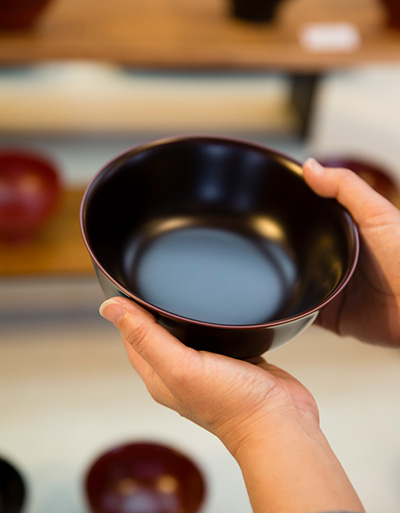
As simple lifestyle is preferred nowadays, the lacquerware with simple design is more popular.
Reference Mitamura, Arisumi (author) “Urushi and Japan – Pursuit of the Mystery of Beauty” – Ribun Shuppan
Yamamoto, Katsumi (author) “Urushi Encyclopedia” – Maruzen
Yotsuyanagi, Kasho “Cultural History of Urushi” – Iwanami Shoten Publishers
Matsuda, Gonroku “The Story of Urushi” – Iwanami Shoten Publishers


